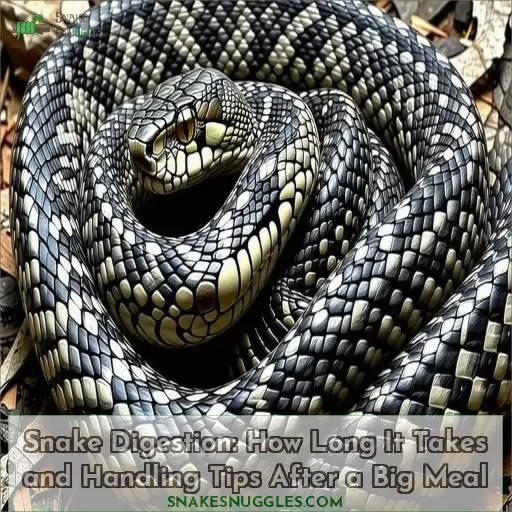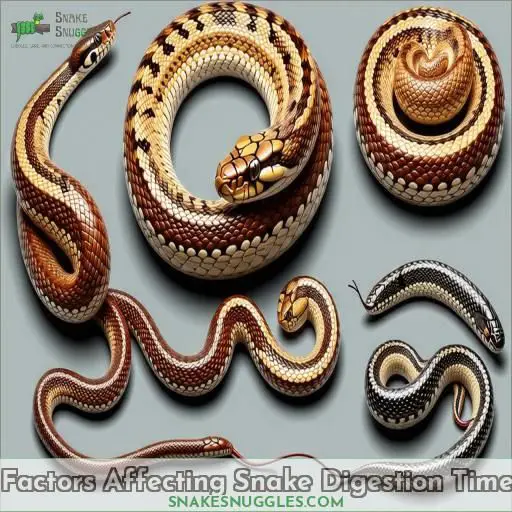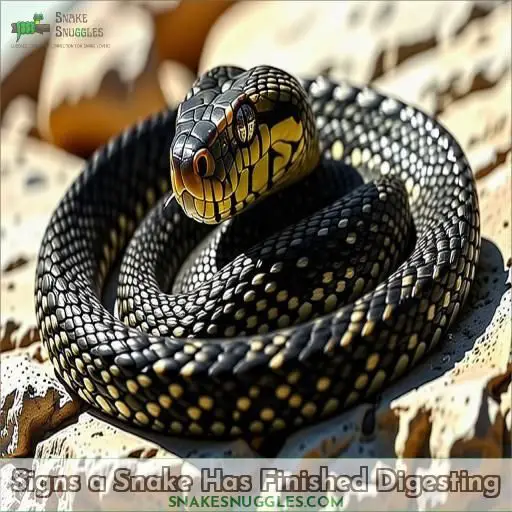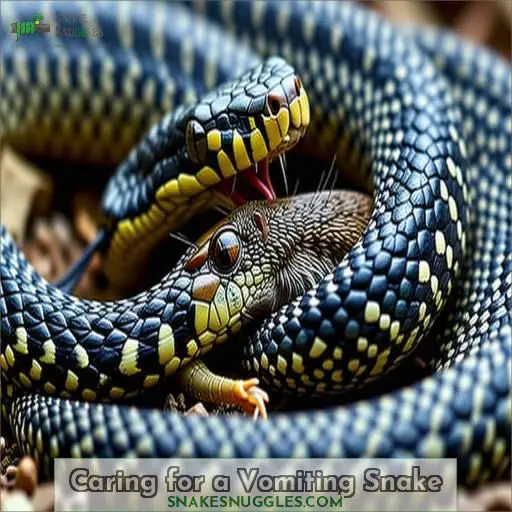This site is supported by our readers. We may earn a commission, at no cost to you, if you purchase through links.

ell, it depends on various factors like species, prey size, and temperature.G
enerally, small meals take 24-72 hours, while larger prey could take weeks or even months to fully digest.T
he key is monitoring your snake’s food bulge – once it disappears, usually within 3 days for small meals, that’s a good sign digestion is complete.B
ut be careful handling during this time as stress can lead to vomiting or organ damage.L
et your snake rest and you’ll learn the signs it’s ready for activity again.
Table Of Contents
- Key Takeaways
- How Long Does It Take Snakes to Digest Their Food?
- Factors Affecting Snake Digestion Time
- Average Digestion Times
- Signs a Snake Has Finished Digesting
- Risks of Handling During Digestion
- Recommended Handling Times
- Caring for a Vomiting Snake
- Frequently Asked Questions (FAQs)
- How long does a snake take to digest food?
- How long can a snake go without eating?
- How long does it take a snake to digest an alligator?
- How long after a snake eats can it be held?
- Do snakes ever get constipated?
- Can snakes digest bones and fur?
- How does snake digestion compare to human digestion?
- Do snakes drink water during digestion?
- Can snakes move around while digesting?
- Conclusion
Key Takeaways
- Digestion time depends on factors like species, prey size, and temperature. Small meals take 24-72 hours, while larger prey could take weeks or months to fully digest.
- The size and species of a snake, the size of its prey, and the surrounding temperature considerably influence digestion time. Younger snakes, smaller species, and warmer temperatures speed up digestion.
- Signs a snake has finished digesting include the food bulge disappearing, the snake becoming more active and alert again, and the snake shedding its skin in some cases.
- Handling a snake during digestion carries risks like vomiting, potential organ damage, and putrefaction. It’s recommended to wait at least 24-72 hours before attempting to lift a snake after it has eaten, and longer for larger meals.
How Long Does It Take Snakes to Digest Their Food?
The time it takes for snakes to digest their food can vary greatly, but typically ranges from 3-5 days for small meals to several months for extremely large prey. The digestion time depends on factors like the snake’s species, size, and the size of the prey, as well as the ambient temperature.
Factors Affecting Snake Digestion Time
A snake’s digestion time hinges on several key factors: its species and size, the size of its prey, and the surrounding temperature. These variables considerably influence how long it takes a snake to fully digest and pass an ingested meal.
Species and Size
The size and species of a snake have a considerable impact on its digestion time. Younger snakes have faster metabolisms, enabling them to digest meals more quickly than older snakes. Larger species, such as pythons and boas, take longer to digest due to their slower metabolisms. A snake’s health and environment also play a part in digestion speed.
- Younger snakes digest faster than older snakes
- Larger snake species digest slower than smaller species
- Metabolism slows with age, extending digestion time
- Healthy snakes digest more efficiently than sick snakes
- Ideal temperatures speed up digestion in captive snakes
Prey Size
The size of a snake’s prey directly impacts its digestion time. Larger meals take longer to break down, with some snakes able to consume prey up to 100% of their own body weight. Smaller snakes and juveniles digest more quickly, as their meals are proportionally smaller. Factors like:
- Meal frequency
- Growth ratei
nfluence a snake’s metabolic activity and energy expenditure during digestion. The stomach’s acid and enzymes work to liquefy the meal, which then passes into the intestines for further processing.
Temperature
Warmer temperatures speed up a snake’s metabolism and digestive processes, allowing them to break down prey more efficiently. Conversely, cooler temperatures slow digestion, as the snake’s body functions at a lower metabolic rate. This temperature-dependent digestion is a key adaptation that helps snakes:
- Optimize energy expenditure during digestion
- Avoid putrefaction of undigested food
- Prevent bacterial buildup in the gut
Average Digestion Times
For small meals, a snake’s digestion typically takes 24-72 hours, though this can vary based on species and environmental factors. Regarding larger prey items, snakes may take several weeks or even months to fully digest the meal in an extreme case, with the digestion period directly correlating to the size of the prey consumed.
Small Meals
For small meals, snakes typically take 24-72 hours to fully digest their prey . During this time, refrain from handling your snake to prevent vomiting and stress . Verify that the enclosure temperature is appropriate to support digestion (Source). Offer smaller prey items that are proportional to your snake’s size for efficient digestion and health .
- Small meals are easier for snakes to digest compared to large meals (Source).
- Pythons and boas are known to consume smaller, more frequent meals .
- Prepare small prey items by thawing completely and warming to the proper temperature .
- Monitor your snake’s behavior and appetite to verify that small meals are being digested properly .
Large Meals
For large meals, snakes may take several weeks to fully digest their prey. Their metabolism slows down, their circulatory system works overtime, and they become vulnerable to predators during this time. The risk of organ damage, putrefaction, and toxic chemicals increases with the size of the meal. Snakes are ambush hunters that can go long periods without eating.
- Snakes’ metabolic activity decreases to conserve energy during digestion of large meals.
- Their circulatory system must work harder to supply blood and oxygen to the digestive organs.
- Snakes are at greater risk of predation while immobilized and sluggish from consuming oversized prey.
Extreme Cases
In extreme cases, snakes may take months to fully digest exceptionally large prey. This extended digestion period poses serious risks, including:
- Organ damage from the immense food bolus.
- Putrefaction and toxic chemical absorption as the meal decomposes.
- Increased aggression if the snake is disturbed while in a vulnerable, post-feeding state.C
aution is paramount when handling snakes that have consumed prey disproportionate to their size.
Signs a Snake Has Finished Digesting
After a sizeable meal, you’ll notice the snake’s food bulge gradually disappearing as digestion progresses. Another clear sign of completed digestion is when the snake becomes active and alert again, shedding its skin in some cases.
Food Bulge Disappears
Once the food bulge disappears, typically within 3 days for small meals, it’s a clear sign your snake has finished digesting. The speed depends on prey type and size, with larger meals taking longer. Monitoring the food bulge is essential for your snake’s health and safe handling. If it persists, consult a vet.
Snake Becomes Active Again
As digestion nears completion, the snake’s activity level and energy consumption will increase.I
ts movement habits may shift from sluggish to more active as the digestive process winds down.T
his uptick in activity is a clear sign the snake has finished digesting its meal.H
owever, the exact length of digestion can vary widely based on factors like prey size and snake species.
Snake Sheds
As a snake finishes digesting a large meal, it may shed its skin. This shedding process is a natural part of a snake’s growth and can occur more frequently after consuming a substantial prey item. Signs that a snake has completed digestion include:
- The food bulge disappears from the snake’s body.
- The snake becomes more active and alert.
- The snake’s skin begins to loosen and peel off.
Risks of Handling During Digestion
Handling a snake during the digestive process during the lengthy digestion process carries significant risks. You should avoid disturbing the snake, as it can lead to vomiting, potential organ damage from the undigested meal shifting abruptly, or the spread of bacteria from partially-digested and putrefying prey within the snake’s body.
Vomiting
Vomiting can be a defense mechanism for snakes when they feel threatened or stressed.F
actors like fear, handling, overeating, and illness can all trigger this response.I
f your snake vomits, make sure it has access to clean water. Soak it the next day, and wait 7-10 days before offering a smaller meal.A
void handling for several hours after vomiting, as the snake may be more aggressive.
Organ Damage
When handling a snake during digestion, risks of organ damage include:
- Vulnerability to Regurgitation: Handling can trigger regurgitation, impacting digestion.
- Exposure to Toxins and Infection: Organ damage may facilitate the release of toxins and increase infection risk.
- Heightened Risk of Organ Damage: Moving a snake with a substantial meal can lead to internal injuries and potential organ damage.
Putrefaction
If a snake can’t fully digest a large meal, the food can begin to rot inside its body, causing putrefaction. This leads to bloating, regurgitation, and potentially fatal bacterial infections. To avoid this, never handle a snake that has recently eaten a meal too large for it to comfortably digest.
- Putrefaction occurs when undigested food rots inside a snake
- Rotting food causes bloating, regurgitation, and bacterial infections
- Handling a snake with a meal too large for it to digest can be fatal
- Never handle a snake that has recently eaten an oversized meal
Recommended Handling Times
Regarding handling your snake post-meal, it’s imperative to wait a minimum of 24-72 hours before attempting to lift it. This allows for the digestive process to commence fully, minimizing the likelihood of regurgitation. For larger meals, an extended waiting period may be necessary – sometimes even several weeks for substantial prey items.
The key is to observe your snake’s body closely. If the food bulge remains visible after 3 days, refrain from handling until it has completely disappeared. Establishing a regular feeding schedule, avoiding overfeeding, is also essential for their digestive health and to prevent regurgitation. By respecting your snake’s requirements during this critical time, you can facilitate a smooth, stress-free digestion.
Caring for a Vomiting Snake
If your snake vomits, act promptly to minimize stress and health risks.P
rovide fresh, clean water and soak the snake for an hour the following day to help flush out any remaining undigested matter.A
fter soaking, delay offering a new, smaller meal for 7-10 days, allowing ample recovery time.A
void handling your snake for several hours after vomiting, as the experience is distressing, and snakes may become defensive.
Provide Clean Water
If your snake vomits, it’s vital to confirm it has access to clean, fresh water. Provide a shallow water dish large enough for the snake to soak in. This will help rehydrate the snake and flush out any remaining vomit or debris. Keep the water clean and change it regularly to maintain a healthy environment.
- Provide a shallow water dish
- Confirm the water is clean and fresh
- Allow the snake to soak and rehydrate
- Change the water regularly
Soak the Snake
To effectively care for a vomiting snake, soaking is essential. Here’s a guide to snake soaking:
- Maintain an appropriate soak duration, typically for an hour.
- Make sure the soak temperature is lukewarm.
- Perform soaking infrequently to avoid stressing the snake unnecessarily.
Offer Smaller Meal
After your snake vomits, it’s important to offer a smaller meal when feeding again. This helps avoid further stress and digestive issues. Stick to prey that’s no more than 1.5 times the width of your snake’s body. Reintroduce food slowly, giving their system time to recover. Be mindful of potential aggression, as snakes may strike when feeling threatened after vomiting.
- Offer smaller prey size
- Reintroduce food slowly
- Watch for post-vomit aggression
- Avoid overfeeding risks
- Prioritize stress management
Avoid Handling
Avoid handling a snake for several hours after it has vomited. Snakes may become aggressive when stressed from handling after regurgitating a meal. To keep your snake safe:
- Provide access to clean water.
- Soak the snake for an hour the next day.
- Wait 7-10 days before offering a smaller meal.
- Limit handling to essential care until the snake has fully recovered.
Frequently Asked Questions (FAQs)
How long does a snake take to digest food?
Whoa there, buddy! Snakes take an eternity (3-5 days for small meals, weeks for huge ones) to digest their grub. Their marathon digestion requires boosted metabolism and serious patience. Don’t blink, or you’ll miss their next feast!
How long can a snake go without eating?
Healthy adult snakes can survive 6-12 months without food. However, prolonged fasting weakens them. You should feed captive ones every 2-6 weeks based on species and size for ideal health.
How long does it take a snake to digest an alligator?
The snake’s enzymes and stomach acid slowly break down that massive meal. You’ll see the snake barely move as its digestive system works overtime.
How long after a snake eats can it be held?
Say your snake just ate a large rat. You’ll want to wait at least 24-72 hours before handling to avoid regurgitation. For bigger meals, give it a few weeks to fully digest before any interaction.
Do snakes ever get constipated?
Yes, snakes can experience constipation due to improper feeding, dehydration, or underlying health issues. Monitor bowel movements and provide proper humidity, heating, and diet to prevent complications.
Can snakes digest bones and fur?
Typically, snakes can digest bones but not fur or feathers. You’ll find these undigested materials in their waste. Their powerful digestive juices break down bone over several days.
How does snake digestion compare to human digestion?
Savor snake’s sluggish digestion, your body blazes in comparison. While you break meals, serpents slowly dissolve and absorb nutrients from monolithic feasts over weeks.
Do snakes drink water during digestion?
Yes, snakes should have access to clean water during digestion. You’ll want to provide a shallow water bowl, as drinking aids the digestive process and prevents dehydration.
Can snakes move around while digesting?
Like a slow-moving slalom, snakes can cautiously slither around as they digest, but vigorous movement risks regurgitation. For safety, limit handling until that meal-bulge subsides.
Conclusion
You’ll be surprised how long it takes snakes to digest their food.W
hile small meals digest within 24-72 hours, larger prey could linger in their system for weeks or months.M
onitor that bulge—once it vanishes, typically within 3 days for smaller meals, digestion is likely complete.A
void handling during this sensitive period to prevent vomiting or organ damage.W
ith patience and care, you’ll learn when your serpentine companion is ready for activity again.












